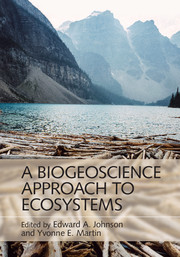Book contents
- Frontmatter
- Contents
- List of contributors
- Preface
- Miscellaneous Frontmatter
- 1 Introduction
- Part I Connecting Ecosystem and Geoscience Processes
- Part II Transport Processes and Conservation Budgets in Biogeoscience
- Part III Coupling Hillslope Geomorphology, Soils, Hydrology, and Ecosystems
- 5 Landscape Evolution Models and Ecohydrologic Processes
- 6 Soil Mantled Hillslopes: Intersections of Geomorphology, Soil Science, and Ecology
- 7 Interactions between Precipitation and Vegetation Canopies
- 8 Constraints on Nutrient Dynamics in Terrestrial Vegetation
- 9 Evapotranspiration
- Part IV Coupling Fluvial and Aeolian Geomorphology, Hydrology/Hydraulics, and Ecosystems
- Index
- References
6 - Soil Mantled Hillslopes: Intersections of Geomorphology, Soil Science, and Ecology
from Part III - Coupling Hillslope Geomorphology, Soils, Hydrology, and Ecosystems
Published online by Cambridge University Press: 27 October 2016
- Frontmatter
- Contents
- List of contributors
- Preface
- Miscellaneous Frontmatter
- 1 Introduction
- Part I Connecting Ecosystem and Geoscience Processes
- Part II Transport Processes and Conservation Budgets in Biogeoscience
- Part III Coupling Hillslope Geomorphology, Soils, Hydrology, and Ecosystems
- 5 Landscape Evolution Models and Ecohydrologic Processes
- 6 Soil Mantled Hillslopes: Intersections of Geomorphology, Soil Science, and Ecology
- 7 Interactions between Precipitation and Vegetation Canopies
- 8 Constraints on Nutrient Dynamics in Terrestrial Vegetation
- 9 Evapotranspiration
- Part IV Coupling Fluvial and Aeolian Geomorphology, Hydrology/Hydraulics, and Ecosystems
- Index
- References
Summary
Introduction
Hillslopes are the most common landforms on the earth's surface, are fundamental drivers of the distribution of soil properties and landscape-scale geomorphic processes and, together with surface waters, form watersheds that are amenable to constraining and balancing the fluxes of water, solutes, and sediments (Bormann, 1994). For these reasons, hillslopes have long been the subject of study for soil scientists, biogeochemists, and geomorphologists.
Although hillslopes are virtually ubiquitous as a landform, most current concepts of terrestrial ecosystem development are built upon studies of soils formed on flat and stable geomorphic surfaces. This bias toward geomorphically inactive land surfaces has been further reinforced by the agronomic legacy involved in the development of the modern field of soil science (Amundson and Yaalon, 1995; Yallon and Berkowicz, 1997). This presents an opportunity to assess the appropriateness of our current concepts of soil formation for understanding the past, present, and future of hillslope soils and hilly ecosystems.
The nexus between hillslopes, anthropogenic systems, and food security continues to intensify and this trend, though complex in its biophysical and socioeconomic contexts (Kiage, 2013), is only growing with populations that are still in upward motion (Conway and Wilson, 2012). A major challenge to researchers remains in understanding exactly how biophysical factors such as climate and soil properties converge under increasing land-use pressure in causing excessive soil degradation (Kiage, 2013).
Hillslope soil processes are thus critical for deepening our understanding of the developments of both natural and anthropogenic ecosystems. This chapter examines the interaction of physical, chemical, and biological processes in the formation of hillslope soils and the ecosystems they support, and emphasizes the fact that these interactions are strongly intertwined on hillslope landforms, where it is difficult to isolate one soil-forming process and examine it independently of the others. Nonetheless, constraining a set of pedogenic processes involving mass and volume fluxes on hillslopes in order to develop a unified theoretical framework for the evaluation of hillslope soil development has become achievable and necessary.
In this chapter, we begin by focusing on the physical processes responsible for shaping hillslope soils – temporarily placing chemical and biological processes into black boxes in the early part of the chapter.
- Type
- Chapter
- Information
- A Biogeoscience Approach to Ecosystems , pp. 180 - 214Publisher: Cambridge University PressPrint publication year: 2016
References
- 2
- Cited by



